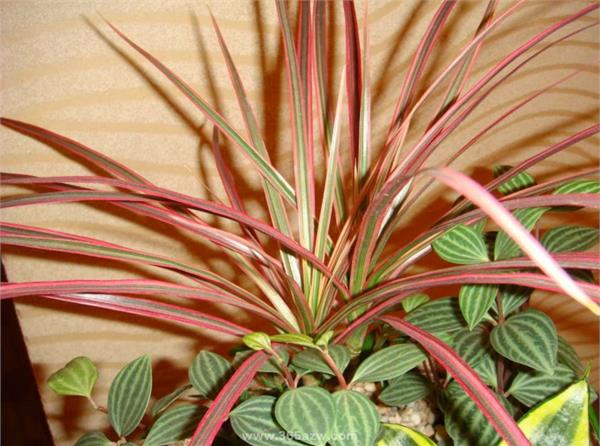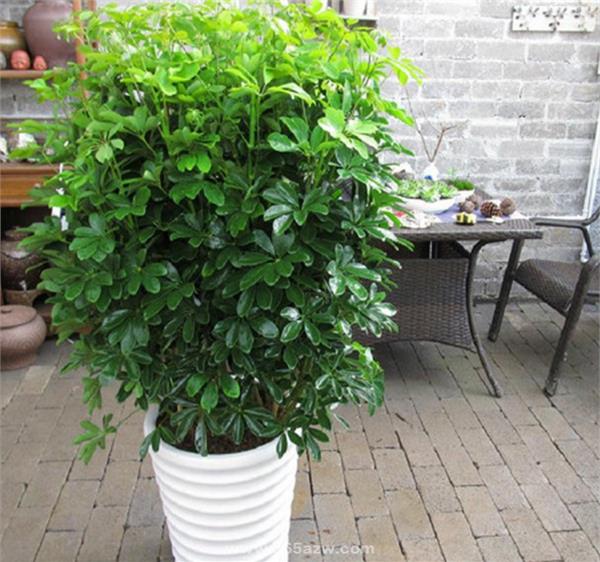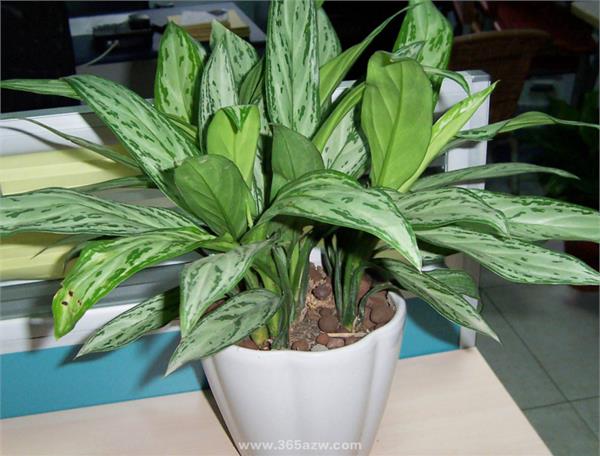16 species of indoor plants capable of decontamination
Indoor plants actually have a lot of knowledge, and many plants have invisible effects, such as removing air pollution and reducing harmful gases. Here are 16 kinds of indoor plants that can be decontaminated.

16 species of indoor plants capable of decontamination
1. Thousand-year wood
As long as you pay a little attention to it, it can grow for a long time and bring good air. It is difficult for other plants to compare with millennium wood in terms of inhibiting harmful substances. Leaves and roots can absorb xylene, toluene, trichloroethylene, benzene and formaldehyde, and decompose them into non-toxic substances.
Light conditions: neutral plants, suitable for planting in semi-shade
Required maintenance: keep the basin soil moist and fertilize regularly
Can be removed: toluene, xylene, benzene, trichloroethylene, formaldehyde
two。 Ivy
Ivy can effectively resist the carcinogens in nicotine. Through the tiny pores in the leaves, ivy can absorb harmful substances and convert them into harmless sugars and amino acids.
Light conditions: neutral plants, suitable for planting in semi-shade
Required maintenance: keep the basin soil moist and fertilize regularly
Can be removed: formaldehyde, nicotine
3. White palm
White palm is an "expert" who suppresses exhaust gases exhaled by the body, such as ammonia and acetone. It can also filter benzene, trichloroethylene and formaldehyde in the air. Its high evaporation rate can prevent dryness of nasal mucosa and greatly reduce the possibility of disease.
Light conditions: shade-loving plants, suitable for warm, shady and humid environment
Required maintenance: keep the basin soil moist and fertilize regularly, and the leaves need to be sprayed frequently.
Can be removed: ammonia, acetone, benzene, trichloroethylene, formaldehyde
4. Hanging orchid
The hanging orchid that is placed in the bathroom, windowsill or shelf is very eye-catching, its slender and graceful branches and leaves can effectively absorb formaldehyde released by curtains and fully purify the air. The hanging orchid naturally drooping branches and leaves are very beautiful, when the branches are luxuriant, it will occasionally turn slightly. And it's not complicated to take care of it.
Light conditions: neutral plants
Required maintenance: keep the basin soil moist
Can be removed: formaldehyde

5. Sunflower with loose tail
Sunflower can evaporate a liter of water every day, which is the best natural "humidifier". In addition, its green palm leaves are very effective in purifying xylene and formaldehyde. Often spraying water on plants can not only keep them green, but also clean the stomata on the leaves.
Light conditions: sunny plants, need plenty of sunlight
Required maintenance: keep the basin soil moist and fertilize regularly
Can remove: xylene, toluene, formaldehyde
6. Boston fern
Boston fern absorbs about 20 micrograms of formaldehyde per hour, so it is considered to be the most effective biological "purifier". People who deal with paint or paint all day long, or people who like to smoke around them, should put at least one fern in the workplace.
Light conditions: neutral plants, like semi-overcast environment
Required maintenance: keep the basin soil moist and spray water frequently
Can remove: xylene, toluene, formaldehyde
7. Duck palm wood
Duck palm wood brings fresh air to smoking families. Its beautiful duck's paw-shaped leaves absorb nicotine and other harmful substances from the smoky air and convert them into harmless plant-owned substances through photosynthesis.
Duck palm wood has no high requirements for the growth environment, so it is very suitable for inexperienced growers. If the twig near the bud is pruned, it can grow up to 3 meters tall and is very beautiful and dense. The larger duck palm wood needs to be reinforced with bamboo poles.
Light conditions: neutral plants
Required maintenance: appropriate watering, do not like too wet soil
Can be removed: nicotine
8. Pendulous leaf banyan
This kind of plant shows many excellent characteristics. It increases the humidity of the room and is good for our skin and breathing. At the same time, it can also absorb formaldehyde, xylene and ammonia and purify the turbid air.
Light conditions: neutral plants, suitable for planting in semi-shade
Required maintenance: sufficient moisture to keep the basin soil moist
Can remove: formaldehyde, toluene, xylene, ammonia

9. Golden Pueraria lobata
Golden Pueraria can "work" in an environment that other indoor plants cannot adapt to. Through a process similar to photosynthesis, it can break down toxic substances released from fabrics, walls and smoke into plant-owned substances.
This kind of plant is easy to take care of and can grow well even in dark environments, making it the best choice for beginners.
Light conditions: shade-loving plants
Required maintenance: moderate moisture, trace fertilizer
Can be removed: formaldehyde, benzene, carbon monoxide, nicotine
10. Pocket coconut
It is a high efficiency air purifier. Because it can purify benzene, trichloroethylene and formaldehyde in the air at the same time, it is very suitable to be placed in the newly decorated room.
Light conditions: neutral plants, suitable for planting in semi-shade
Required maintenance: sufficient moisture to keep the basin soil moist
Can remove: benzene, trichloroethylene, formaldehyde
11. And fruit taro
It can increase air humidity and absorb a lot of formaldehyde and ammonia. The more leaves there are, the more powerful it is to filter and purify the air and moisturize.
twelve。 Queen of Silver
The Silver Queen is famous for its unique air purification ability: the higher the concentration of pollutants in the air, the more it can exert its purification ability! Therefore, it is very suitable for dark rooms with poor ventilation.
This kind of plant with gray leaves likes to live in a constant temperature. If it is watered with warm water, it can survive for a long time.

13. Green basket
The smell of household cleaning detergents and lampblack is also harmful to human health. Put or hang a pot of vines such as green baskets in the corner of the kitchen or bathroom, which can effectively absorb the chemicals in the air and resolve the residual smell after decoration.
Nursing common sense: can not accept strong direct sunlight, suitable for indoor mild light. Need to water every day to keep the soil moist, but do not accumulate water to breed mosquitoes. Fertilizing once every one or two months can make the leaves more shiny and bright, but the fertilizer should not come into direct contact with the leaves.
14. Cactus
Radiation from computers, televisions and various electrical appliances has always been a major source of household air pollution. Putting a pot of cactus plants near these appliances can absorb a lot of radiation pollution.
Nursing knowledge: water once every 5 to 10 days, do not drench directly on the pulp when watering. Fertilize once a month or two.
15. Green emperor yellow
Such plants have broad leaves that effectively absorb large amounts of carbon dioxide and release oxygen, making the air feel fresh. If you put a basin in the living room, you can breathe the purified fresh air as soon as you get home from the exhaust-filled road. Is it refreshing immediately?
Nursing common sense: like high temperature and high humidity, so you should always spray water to keep the leaves green and bright. Avoid direct sunlight in summer. Fertilize twice a month to keep the leaves fat and shiny.
16. Artemisia argyi
Moxa grass is a plant that calms the mind and helps sleep. A small pot is placed at the head of the bed or in front of the dresser in the bedroom, decorating with green and emitting the smell of sleep, so that you can have a sweet sleep every night.
Required maintenance: sufficient moisture to keep the basin soil moist
Can remove: benzene, trichloroethylene, formaldehyde
11. And fruit taro
It can increase air humidity and absorb a lot of formaldehyde and ammonia. The more leaves there are, the more powerful it is to filter and purify the air and moisturize.
twelve。 Queen of Silver
The Silver Queen is famous for its unique air purification ability: the higher the concentration of pollutants in the air, the more it can exert its purification ability! Therefore, it is very suitable for dark rooms with poor ventilation.
This kind of plant with gray leaves likes to live in a constant temperature. If it is watered with warm water, it can survive for a long time.

13. Green basket
The smell of household cleaning detergents and lampblack is also harmful to human health. Put or hang a pot of vines such as green baskets in the corner of the kitchen or bathroom, which can effectively absorb the chemicals in the air and resolve the residual smell after decoration.
Nursing common sense: can not accept strong direct sunlight, suitable for indoor mild light. Need to water every day to keep the soil moist, but do not accumulate water to breed mosquitoes. Fertilizing once every one or two months can make the leaves more shiny and bright, but the fertilizer should not come into direct contact with the leaves.
14. Cactus
Radiation from computers, televisions and various electrical appliances has always been a major source of household air pollution. Putting a pot of cactus plants near these appliances can absorb a lot of radiation pollution.
Nursing knowledge: water once every 5 to 10 days, do not drench directly on the pulp when watering. Fertilize once a month or two.
15. Green emperor yellow
Such plants have broad leaves that effectively absorb large amounts of carbon dioxide and release oxygen, making the air feel fresh. If you put a basin in the living room, you can breathe the purified fresh air as soon as you get home from the exhaust-filled road. Is it refreshing immediately?
Nursing common sense: like high temperature and high humidity, so you should always spray water to keep the leaves green and bright. Avoid direct sunlight in summer. Fertilize twice a month to keep the leaves fat and shiny.
16. Artemisia argyi
Moxa grass is a plant that calms the mind and helps sleep. A small pot is placed at the head of the bed or in front of the dresser in the bedroom, decorating with green and emitting the smell of sleep, so that you can have a sweet sleep every night.
Related
- Wuhan Hospital Iron Tree Blooming Result Was Instantly Frightened by the Gardener Master
- Which variety of camellia is the most fragrant and best? Which one do you like best?
- What is the small blue coat, the breeding methods and matters needing attention of the succulent plant
- Dormancy time and maintenance management of succulent plants during dormancy
- Minas succulent how to raise, Minas succulent plant pictures
- What are the varieties of winter succulent plants
- How to raise succulent plants in twelve rolls? let's take a look at some experience of breeding twelve rolls.
- Attention should be paid to water control for succulent plants during dormant period (winter and summer)
- Watering experience of twelve rolls of succulent plants
- Techniques for fertilizing succulent plants. An article will let you know how to fertilize succulent plants.



